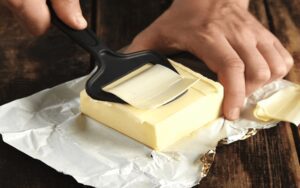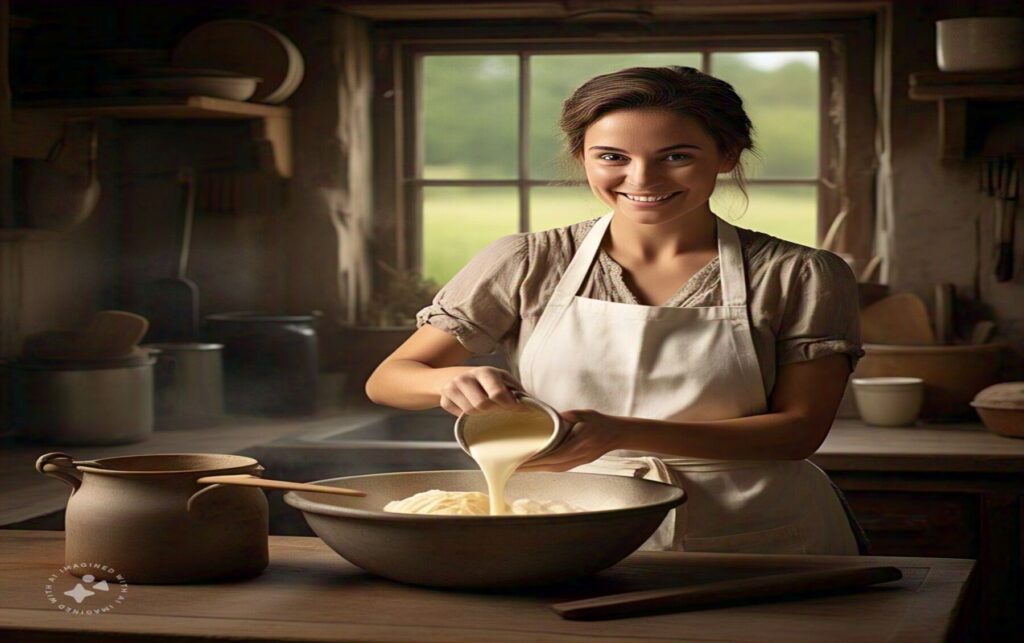Making butter from raw milk is a fun and simple way to enjoy fresh, homemade butter. If you’ve ever wondered how to make butter with raw milk, it’s actually easier than you might think! All you need is some heavy cream from raw milk, and a little patience. Whether you’re using cow’s milk or any other fresh milk, the process involves separating the cream and churning it until it turns into smooth, creamy butter. So, if you’re curious about how to make butter from raw milk?
This step-by-step guide will show you how to create delicious butter right from the comfort of your kitchen! We will guide you about the process of making butter from raw milk but befor process the ingreadiants and tools must be available with you.
Ingredient to make a butter from raw milk
- Raw Milk: Fresh, unpasteurized milk is the primary ingredient. It contains the cream needed to make butter.
- Salt: (Optional) To enhance flavor and act as a natural preservative. A sea Salt could be more decisions for it.
Tools for making Butter From Raw milks
There a few general kitchen Tools are required for Making butter from milk. Here are the following.
- Stainless Steel Container for Milk: A large, shallow bowl or container to allow the cream to rise naturally.
- Ladle or Skimmer: For skimming the cream from the milk after it has separated.
- Churner or Mixer: Hand Churner: A traditional butter churn for manual churning.
- Electric Mixer: A stand mixer or hand mixer for easier and faster churning.
- Blender or Food Processor: Another modern alternative for churning.
- Jar with a Lid: For the shake method, where cream is agitated by shaking.
- Strainer or Cheesecloth: To separate the butter solids from the buttermilk.
Process of Making Butter from raw milk
Once you get settle everything that is required, You can start the process of making butter from the fresh milk. There are 4 steps Skimming Cream from Raw Milk, prepearing heavy cream, shaking and straining the butter and kneading and storing the butter. to follow to make a butter from fresh milk. Here is a detailed guide of how to follow each step.
Cool or Refrigerate the Milk
The first step of making butter is to pour the milk into a large container. If the container is stainless steel, that would be great for refrigeration because it is hygienic, safe, durable, and helps purify the butter. Refrigerate the milk for a minimum of 18 hours. This will create a layer of cream.
Once the cream layer is created on the top of the milk, slowly dip the skimmer from one side and take out all the cream that is available on milk.
Culture the Cream (Optional)
This is optional process for the flavor of butter. Culturing cream in butter-making enhances flavor, texture, and quality by fermenting the cream with bacteria like Lactococcus lactis, which produce lactic acid and other compounds that create a tangy, rich flavor. This process also improves the butter’s texture, making it smoother and more spreadable, while the lowered pH acts as a natural preservative, increasing shelf life. Additionally, it can introduce probiotics, enhance emulsification for easier churning, and reflects traditional practices that mimic natural fermentation, resulting in butter with a more complex and luxurious profile.
How to Culture the Cream?
To culture cream for a slightly tangy flavor, simply stir ½ tablespoon (7 ml) of buttermilk into every 1 cup (240 ml) of cream you’ve skimmed. For instance, if you’ve skimmed 2 cups (470 ml) of cream, add 1 tablespoon (15 ml) of buttermilk. This step introduces beneficial bacteria that ferment the cream, creating the characteristic tangy taste of cultured butter. If you prefer a classic, non-tangy butter, skip this step and omit the buttermilk.
You can use a mixture to blend the milk into the cream. Leave the cream for 72 hours to culture. Then, transfer the cream into a jar. Before transferring, boil the jar in warm water to remove any bacteria. This will prevent it from reacting with the cream and potentially causing it to spoil
To ripen the cream, place the jar in warm water for 5 to 12 hours. Put the jar in a cooler and fill it with enough warm water to reach halfway up the jar. Let the cream sit until it warms up to 75°F (24°C). You can use a  thermometer to check the temperature or feel the jar to see if it’s warm. If you didn’t add buttermilk, the cream will need about 12 hours, but if it’s cultured, it will take around 5 hours.
thermometer to check the temperature or feel the jar to see if it’s warm. If you didn’t add buttermilk, the cream will need about 12 hours, but if it’s cultured, it will take around 5 hours.
Next, chill the jar of cream in ice water for 5 to 10 minutes. Fill a bowl with ice water and put the jar in it until the cream feels cold, between 50°F and 60°F (10°C and 15°C). Keep the ice water for later. Chilling the cream helps make it easier to turn into butter.
Making Butter from the Cream
After separating the cream from raw milk, you can take the next step and turn it into butter. This process involves churning the cream until the butterfat solidifies and separates from the buttermilk. Churning can be done manually using a butter churn or with the help of a stand mixer, making the process easier and faster. Here’s a more detailed guide to making butter:
- Pour the Cream into a Bowl or Mixer: Start by transferring the separated cream into a clean bowl or the bowl of a stand mixer. If you are using a stand mixer, choose a large enough bowl to allow for the cream to move around freely during churning.
- Churn the Cream: Begin churning the cream, either by hand using a butter churn or by turning on the mixer. At first, the cream will whip into a soft, fluffy whipped cream. Continue churning past this point, and the cream will begin to thicken further. After some time, the butterfat will separate from the buttermilk, and you’ll notice the creamy butter and thin, watery buttermilk.
- Separate the Butter from the Buttermilk: Once the butter has formed, you’ll need to drain off the buttermilk. You can do this by pouring the mixture through a fine strainer or cheesecloth, or simply using your hands to press the butter against the side of the bowl to squeeze out the remaining liquid. Be sure to save the buttermilk for other uses, such as baking or cooking.
- Rinse the Butter: After the buttermilk has been drained, it’s important to rinse the butter with cold water. This step helps remove any remaining buttermilk from the butter, ensuring it has a longer shelf life and preventing it from spoiling quickly. Simply place the butter under cold running water or in a bowl of ice water and gently press the butter to expel any liquid.
- Optional: Add Salt: If you prefer salted butter, this is the perfect time to add a pinch of salt. This step is optional, depending on your taste preferences. Use about 1/4 to 1/2 teaspoon of salt per cup of butter for a mild flavor, or adjust it to your liking.

